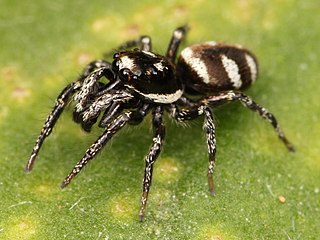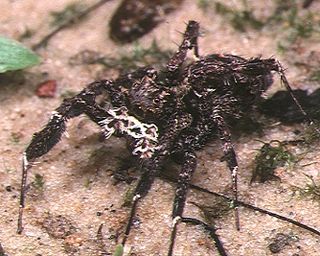
Predation is a biological interaction where one organism, the predator, kills and eats another organism, its prey. It is one of a family of common feeding behaviours that includes parasitism and micropredation and parasitoidism. It is distinct from scavenging on dead prey, though many predators also scavenge; it overlaps with herbivory, as seed predators and destructive frugivores are predators.

Amblypygi is an order of arachnid chelicerate arthropods also known as whip spiders or tailless whip scorpions. The name "amblypygid" means "blunt tail", a reference to a lack of the flagellum that is otherwise seen in whip scorpions. Amblypygids possess no silk glands or venomous fangs. They rarely bite if threatened, but can grab fingers with their pedipalps, resulting in thorn-like puncture injuries.

Jumping spiders are a group of spiders that constitute the family Salticidae. As of 2019, this family contained over 600 described genera and over 6,000 described species, making it the largest family of spiders at 13% of all species. Jumping spiders have some of the best vision among arthropods and use it in courtship, hunting, and navigation. Although they normally move unobtrusively and fairly slowly, most species are capable of very agile jumps, notably when hunting, but sometimes in response to sudden threats or crossing long gaps. Both their book lungs and tracheal system are well-developed, and they use both systems. Jumping spiders are generally recognized by their eye pattern. All jumping spiders have four pairs of eyes, with the anterior median pair being particularly large.

The zebra spider is a common jumping spider of the Northern Hemisphere. Their common name refers to their vivid black-and-white colouration, whilst their scientific name derives from Salticus from the Latin for “jump”, and the Greek scenicus, translating to “theatrical” or “of a decorative place,” in reference to the flashy, zebra-like coloration of the species.

Belostomatidae is a family of freshwater hemipteran insects known as giant water bugs or colloquially as toe-biters, Indian toe-biters, electric-light bugs, alligator ticks, or alligator fleas. They are the largest insects in the order Hemiptera. There are about 170 species found in freshwater habitats worldwide, with more than 110 in the Neotropics, more than 20 in Africa, almost as many in the Nearctic, and far fewer elsewhere. These predators are typically encountered in freshwater ponds, marshes and slow-flowing streams. Most species are at least 2 cm (0.8 in) long, although smaller species, down to 0.9 cm (0.35 in), also exist. The largest are members of the genus Lethocerus, which can exceed 12 cm (4.5 in) and nearly reach the length of some of the largest beetles in the world. Giant water bugs are a popular food in parts of Asia.

Portia labiata is a jumping spider found in Sri Lanka, India, southern China, Burma (Myanmar), Malaysia, Singapore, Java, Sumatra and the Philippines. In this medium-sized jumping spider, the front part is orange-brown and the back part is brownish. The conspicuous main eyes provide vision more acute than a cat's during the day and 10 times more acute than a dragonfly's, and this is essential in P. labiata′s navigation, hunting and mating.

Phidippus audax, the bold jumper or bold jumping spider, is a common species of spider belonging to the genus Phidippus, a group of jumping spiders easily identified by their large eyes and their iridescent chelicerae. Like all jumping spiders, they have excellent stereoscopic vision that aids them in stalking prey and facilitates visual communication with potential mates during courting. Bold jumping spiders are native to North America and have been introduced to Hawaii, Nicobar Islands, Azores, and the Netherlands. They are typically black with a distinct white triangle on their abdomen.

Argiope argentata, commonly known as the silver argiope or silver garden spider due to the silvery color of its cephalothorax, is a member of the orb-weaver spider family Araneidae. This species resides in arid and warm environments in North America, Central America, the Caribbean and widely across South America. In the United States, it is found at least in Southern California, Florida, Arizona, and Texas. A. argentata create stabilimenta and a unique zig-zag in its web design, and it utilizes its UV-reflecting silk to attract pollinating species to prey upon. Like other species of Argiope, its venom is not harmful to humans; however, it can be employed to immobilize its prey. A. argentata engages in sexual cannibalism either mid- or post-copulation. One aspect of particular interest regarding this species is its extinction patterns, which notably have minimal correlation with its population size but rather occur sporadically for the species.

Ambush predators or sit-and-wait predators are carnivorous animals that capture or trap prey via stealth, luring or by strategies utilizing an element of surprise. Unlike pursuit predators, who chase to capture prey using sheer speed or endurance, ambush predators avoid fatigue by staying in concealment, waiting patiently for the prey to get near, before launching a sudden overwhelming attack that quickly incapacitates and captures the prey.

Aggressive mimicry is a form of mimicry in which predators, parasites, or parasitoids share similar signals, using a harmless model, allowing them to avoid being correctly identified by their prey or host. Zoologists have repeatedly compared this strategy to a wolf in sheep's clothing. In its broadest sense, aggressive mimicry could include various types of exploitation, as when an orchid exploits a male insect by mimicking a sexually receptive female, but will here be restricted to forms of exploitation involving feeding. For example, indigenous Australians who dress up as and imitate kangaroos when hunting would not be considered aggressive mimics, nor would a human angler, though they are undoubtedly practising self-decoration camouflage. Treated separately is molecular mimicry, which shares some similarity; for instance a virus may mimic the molecular properties of its host, allowing it access to its cells. An alternative term, Peckhamian mimicry, has been suggested, but it is seldom used.

Nebalia bipes is a species of leptostracan crustacean, and the first species in the order to have been described. It lives in coastal waters at depths of 5–60 m (20–200 ft), under stones or among decaying organic matter where it is common and sometimes abundant. Its predators include the fish Merlangius merlangus (whiting).

Stenolemus is a genus of thread-legged bug (Emesinae). Species of this genus are noted for preying on spiders.

Spiders are air-breathing arthropods that have eight legs, chelicerae with fangs generally able to inject venom, and spinnerets that extrude silk. They are the largest order of arachnids and rank seventh in total species diversity among all orders of organisms. Spiders are found worldwide on every continent except for Antarctica, and have become established in nearly every land habitat. As of August 2022, 50,356 spider species in 132 families have been recorded by taxonomists. However, there has been debate among scientists about how families should be classified, with over 20 different classifications proposed since 1900.

Seismic or vibrational communication is a process of conveying information through mechanical (seismic) vibrations of the substrate. The substrate may be the earth, a plant stem or leaf, the surface of a body of water, a spider's web, a honeycomb, or any of the myriad types of soil substrates. Seismic cues are generally conveyed by surface Rayleigh or bending waves generated through vibrations on the substrate, or acoustical waves that couple with the substrate. Vibrational communication is an ancient sensory modality and it is widespread in the animal kingdom where it has evolved several times independently. It has been reported in mammals, birds, reptiles, amphibians, insects, arachnids, crustaceans and nematode worms. Vibrations and other communication channels are not necessarily mutually exclusive, but can be used in multi-modal communication.

Portia fimbriata, sometimes called the fringed jumping spider, is a jumping spider found in Australia and Southeast Asia. Adult females have bodies 6.8 to 10.5 millimetres long, while those of adult males are 5.2 to 6.5 millimetres long. Both sexes have a generally dark brown carapace, reddish brown chelicerae ("fangs"), a brown underside, dark brown palps with white hairs, and dark brown abdomens with white spots on the upper side. Both sexes have fine, faint markings and soft fringes of hair, and the legs are spindly and fringed. However, specimens from New Guinea and Indonesia have orange-brown carapaces and yellowish abdomens. In all species of the genus Portia, the abdomen distends when the spider is well fed or producing eggs.

Portia schultzi is a species of jumping spider which ranges from South Africa in the south to Kenya in the north, and also is found in West Africa and Madagascar. In this species, which is slightly smaller than some other species of the genus Portia, the bodies of females are 5 to 7 mm long, while those of males are 4 to 6 mm long. The carapaces of both sexes are orange-brown with dark brown mottling, and covered with dark brown and whitish hairs lying over the surface. Males have white tufts on their thoraces and a broad white band above the bases of the legs, and these features are less conspicuous in females. Both sexes have tufts of orange to dark orange above the eyes, which are fringed with pale orange hairs. Males' abdomens are yellow-orange to orange-brown with blackish mottling, and on the upper sides are black and light orange hairs, and nine white tufts. Those of females are pale yellow and have black markings with scattered white and orange-brown hairs on the upper side. P. schultzi has relatively longer legs than other Portia, and a "lolloping" gait.
Portia africana is a jumping spider found in Angola, Cameroon, the Central African Republic, Gabon, Ghana, the Ivory Coast, Sierra Leone, Zaire and Zambia. Its conspicuous main eyes provide vision more acute than a cat's during the day and 10 times more acute than a dragonfly's, and this is essential in P. africana′s navigation, hunting and mating.

Ogcocephalus radiatus or the polka-dot batfish is an arrow-shaped fish in the family Ogcocephalidae with an elongated thin tail. It is dorso-ventrally flattened with round pectoral fins that sit flat on the bottom of the sea floor. It uses its pectoral fins and pelvic fins to "walk" along the bottom in a side-to-side shuffling motion.
Brettus adonis, is a species of spider of the genus Brettus. It is endemic to Sri Lanka.
Brettus cingulatus is a species of jumping spider of the genus Brettus. It is found in Myanmar and India.
















